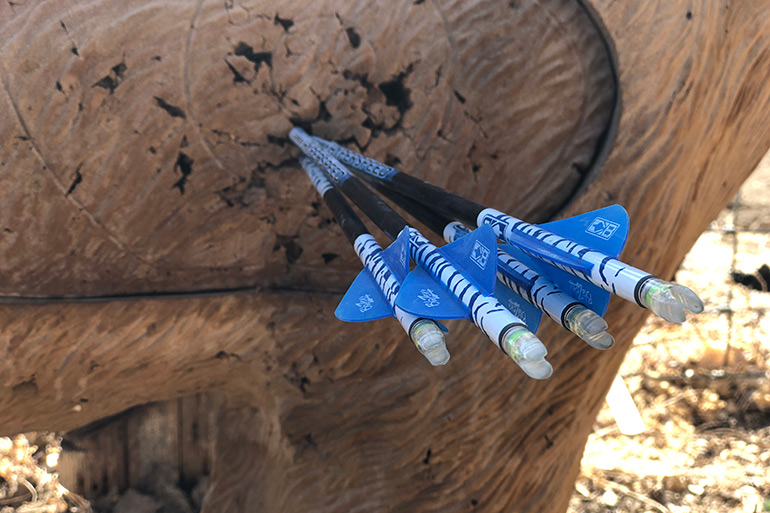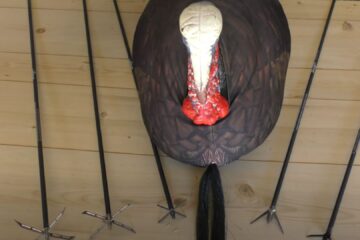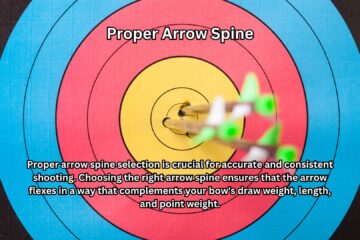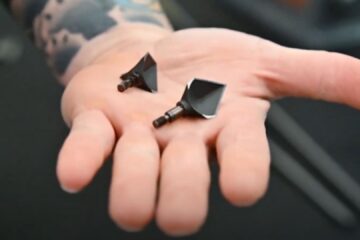There are several types of arrows: traditional, mechanical, and hybrid. Traditional arrows are made of wood or carbon, while mechanical arrows have mechanized features.
Hybrid arrows combine features of both traditional and mechanical arrows. Arrows have been a vital tool for hunting and warfare for centuries. Different types of arrows have been designed to cater to different needs. Traditional arrows are made using wood or carbon, while mechanical arrows have robust features such as broadheads, blades, and cams.
Hybrid arrows, on the other hand, are a combination of both traditional and mechanical arrows. Arrowheads can also vary from blunt, broad, and field points. The type of arrow a person chooses depends on their intended use, whether it is for hunting, target practice, or recreation. This article will explore the various types of arrows and their features.
Understanding Arrow Anatomy
Arrows come in different types and sizes, and understanding their anatomy is crucial when choosing the right one for your needs. This section will explore the different parts of an arrow, the materials used to make them, and how to choose the right arrow.
Parts Of An Arrow
Arrows are made up of several distinct parts, each serving a specific purpose. Here are some of the key parts of an arrow:
- Arrowhead: The tip of the arrow that pierces the target.
- Shaft: The long, straight part of the arrow that transfers energy from the bow to the target.
- Fletching: The feathers or vanes attached to the back of the arrow that serve to stabilize its flight.
- Nock: The notch at the end of the arrow that holds it in place on the bowstring.

Different Materials Used To Make Arrows
Arrows can be made from a variety of materials, each with its unique properties and advantages. Here are some of the most common materials used to make arrows:
- Wood: Wood is a classic choice for arrow making, and it is still popular today. Wooden arrows are typically used for traditional archery and hunting, and they offer a classic look and feel.
- Aluminum: Aluminum arrows are light, fast, and durable. They are used for target shooting and hunting and are ideal for beginners and intermediate archers.
- Carbon: Carbon arrows are the most popular choice for modern archers. They are lightweight, strong, and fast, and they offer unparalleled accuracy and consistency.
- Fiberglass: Fiberglass arrows are affordable and durable, making them an excellent choice for beginners and young archers.
How To Choose The Right Arrow For Your Needs
Selecting the right arrow requires careful consideration of several factors. Here are some tips to help you choose the right arrow for your needs:
- Determine your draw length and weight: These factors determine the length and spine of the arrow you need.
- Consider your shooting style: Different arrows are designed for different types of archery, so choose an arrow that matches your shooting style.
- Think about your intended use: Are you shooting for target practice or hunting? Choose an arrow that is appropriate for your intended use.
- Factor in your budget: Arrows come in a wide range of prices, so choose one that fits your budget while still meeting your needs.
Understanding arrow anatomy is essential when selecting the right arrow for your needs. By considering the different parts of an arrow, the materials used to make them, and how to choose the right arrow, you can become a more informed archer and improve your accuracy and consistency.
Traditional Arrows
Types Of Traditional Arrows (Wood, Bamboo, Etc.)
Traditional arrows come in several types, with each material having different characteristics that serve unique purposes. Below is a brief overview of the different types of traditional arrows:
- Wood arrows: This type of arrow is made of solid wood and is the most common type of traditional arrow. They offer better stability and accuracy than composite or bamboo arrows. Wood arrows are great for indoor and outdoor shooting and last for a long time with proper maintenance.
- Bamboo arrows: These arrows are made of bamboo, which is a fast-growing plant, making it a sustainable option. Bamboo arrows have good penetration and are lightweight, making them ideal for long-range shooting.
- Composite arrows: These arrows are made of wood and other materials, including carbon or aluminum. They are sturdy and durable, allowing for greater accuracy and speed when shooting. Composite arrows are great for hunting and outdoor shooting.
- Carbon arrows: These arrows are made of carbon fibers and are known for their high-velocity speed and accuracy. They are lightweight and durable, making them the preferred choice for competitive archers or hunters.
Characteristics And Benefits Of Each Type
Knowing the characteristics and benefits of each type will help you choose the right traditional arrow for your needs. Here is a breakdown of each type:
- Wood arrows: These arrows are sturdy and durable, with a classic look and feel. They offer great stability in flight and are ideal for long-range shooting. Wood arrows are also great for beginners due to their affordability and ease of use.
- Bamboo arrows: These arrows are lightweight and have excellent penetration. They are a sustainable option for those who value eco-friendliness. Additionally, bamboo arrows offer a unique appearance that sets them apart from other types of arrows.
- Composite arrows: These arrows offer better accuracy and speed than wood arrows due to their unique composition. They are also highly durable and can withstand wear and tear from outdoor shooting and hunting activities.
- Carbon arrows: These arrows are the fastest and most accurate type of traditional arrow. They are lightweight and can be customized to your specific needs. Carbon arrows are the preferred choice for competitive archers or hunters who demand high performance.
Maintenance And Care Tips For Traditional Arrows
Proper maintenance and care of your traditional arrows will ensure their longevity and performance. Here are some tips:
- Store arrows in a dry, cool place, away from sunlight and moisture.
- Avoid storing arrows in a horizontal position, as it can cause them to warp over time.
- Regularly inspect arrows for any signs of cracks, bends, or other damage.
- Clean arrows using a soft cloth to remove dirt or residue.
- Apply wax or oil to wood or bamboo arrows to prevent cracks.
- Replace arrow vanes or feathers if they become loose or damaged.
- Avoid subjecting your arrows to extreme temperatures or humidity.
Understanding the different types of traditional arrows, their characteristics, benefits, and proper maintenance is crucial for any archer or hunter. Choose the arrow that best suits your needs and take good care of it to ensure it lasts a long time and performs optimally.
Modern Arrows
Modern arrows have revolutionized the archery industry, replacing traditional wooden arrows with options that are more durable, faster, and more accurate. In this section, we’ll explore the types of modern arrows available, their advantages over traditional ones, and how to use and maintain them.
Types Of Modern Arrows (Carbon, Aluminum, Etc.)
There are several different types of modern arrows available, each with its unique properties and advantages. Here are some of the most popular options:
- Carbon arrows: These arrows are made from carbon fiber and are incredibly lightweight, making them faster and more accurate than traditional wooden arrows. They’re also incredibly durable and can withstand years of use without breaking.
- Aluminum arrows: These arrows are made from aluminum, making them heavier than carbon arrows but still faster and more accurate than traditional wooden ones. They’re also incredibly durable and can be bent back into shape if they become damaged.
- Fiberglass arrows: These arrows are made from fiberglass and are a popular choice for beginners. They’re less expensive than carbon and aluminum arrows but are also slower and less accurate.
- Hybrid arrows: As the name suggests, these arrows are a combination of different materials, such as carbon and aluminum. They offer a balance between speed, accuracy, and durability.
Advantages Of Modern Arrows Over Traditional Ones
Modern arrows offer several advantages over traditional wooden arrows, including:
- Durability: Unlike wooden arrows, modern arrows are incredibly durable and can last for years without breaking. This reduces the need for frequent replacements and saves money in the long run.
- Speed and accuracy: Modern arrows are faster and more accurate than traditional wooden arrows, making them a popular choice for competitive archers.
- Consistency: Modern arrows are manufactured to precise specifications, resulting in arrows that are more consistent in terms of weight, spine, and other factors. This ensures that each arrow performs the same way, improving accuracy.
How To Use And Maintain Modern Arrows
To get the most out of your modern arrows, follow these tips for use and maintenance:
- Inspect your arrows regularly for signs of damage, such as cracks or bends. Damaged arrows should be replaced immediately to ensure safety.
- Store your arrows in a dry, cool place to prevent warping or other damage.
- Make sure your arrows are the correct length and weight for your bow. Using the wrong arrows can result in poor performance or even injury.
- Clean your arrows after each use to remove dirt and debris that can affect accuracy. Use a soft cloth and mild soap to gently clean the arrow shaft.
- Use arrow lube to reduce friction between the arrow and the bowstring, improving accuracy and extending the life of your arrows.
Specialty Arrows
Types Of Specialty Arrows
Most archers aim to use standard arrows for their everyday shooting. However, they may encounter situations that require them to use specialty arrows. Some of the common types of specialty arrows include fluorescent, broadhead, field point, and blunt arrows.
Fluorescent Arrows
Fluorescent arrows are an excellent choice for low-light conditions. They are easy to spot as they glow in the dark, making them a popular choice for archers who enjoy shooting at night or early in the morning. However, they may not be suitable for all situations, as the fluorescence on some arrows may not be bright enough.
Broadhead Arrows
Broadhead arrows are designed for hunting. They usually have sharp tips that can puncture through the flesh of prey and cause bleeding. They are not suitable for target practice as they can damage targets and other equipment. Therefore, it is crucial to use them only when hunting and not for any other purpose.
Field Point Arrows
Field point arrows have a sharp pointed tip that is ideal for shooting at targets. They are suitable for both indoor and outdoor target practice, making them an all-purpose tool. They are also cost-effective and widely available.
Blunt Arrows
Blunt arrows have a flat tip that does not penetrate the target, but instead, they can be used to knock it down. They are useful for beginners who want to learn the basics of archery without causing any damage. They are also excellent for small game hunting, as they are less likely to take down an animal.
When And How To Use Specialty Arrows
Choosing the right arrow head for a specific task can make a huge difference. Here are some situations when specialty arrows may prove useful:
- Fluorescent arrows can be used in low-light conditions or when shooting in the dark for enhanced visibility.
- Broadhead arrows are ideal for hunting and should not be used for any other purpose to avoid accidents.
- Field point arrows are suitable for both indoor and outdoor target practice sessions.
- Blunt arrows are useful for beginners who want to learn the basics of archery and for small game hunting.
As a rule of thumb, always select an arrow type that best suits the task at hand.
Safety Considerations For Specialty Arrows
While specialty arrows can be beneficial, they also come with specific safety considerations that archers need to remember. Here are some vital safety tips to keep in mind:
- Always wear safety gear, such as eye and ear protection, to avoid accidents.
- Broadhead arrows are very sharp and should only be used under the supervision of a professional.
- When practicing with fluorescent arrows, make sure to remove them from the quiver and keep separate from other arrows to avoid cross-contamination.
- Blunt arrows are not always suitable for hunting, always check the hunting regulations in your area to make sure it’s appropriate.
By following these safety considerations, you can minimize the risk of accidents while enjoying the benefits of specialty arrows.
Frequently Asked Questions On Types Of Arrows
What Are The Different Types Of Arrows Used In Archery?
There are numerous types of arrows used in archery, including wood, aluminum, carbon, and fiberglass. Each material has different properties that affect the arrow’s accuracy, durability, and speed. Additionally, arrows can vary in size and weight, depending on the intended use and the type of bow being used.
How Do You Choose The Right Type Of Arrow For Your Bow?
To choose the right type of arrow for your bow, you need to consider a few factors. First, the arrow should be compatible with your bow’s draw weight and length. Additionally, you should determine whether you need an arrow for hunting or target shooting and consider the arrow’s material, length, and weight.
What Is A Fletching And How Does It Affect Arrow Performance?
Fletchings are the feathers or vanes found at the back end of an arrow. They help stabilize and guide the arrow during flight, improving its accuracy and speed. The type and arrangement of the fletchings can significantly impact an arrow’s performance, with longer, offset fletchings typically used for hunting and shorter, straight fletchings used for target shooting.
What Is The Difference Between A Broadhead And A Field Point?
Broadheads and field points are different types of arrowheads used for different purposes. Broadheads have sharp blades intended for hunting, while field points have a blunt tip meant for target shooting. Additionally, broadheads can vary in size and shape, with fixed-blade and mechanical options available.
How Should You Store Your Arrows To Keep Them In Good Condition?
To keep your arrows in good condition, you should store them in a cool, dry place, ideally in a quiver or arrow case. Avoid putting pressure on the fletchings, and make sure the arrows are not exposed to extreme temperatures or moisture.
Additionally, regularly inspect the arrows for signs of damage or wear and replace any that show significant wear.
Conclusion
Arrows are simple yet critical weapons that have been in use for thousands of years. With time, the making of these projectiles has evolved, leading to different types of arrows. From traditional wooden arrows to modern aluminum and carbon arrows, all arrows serve the same purpose, but each comes with its unique features and advantages.
They can be used in various activities, including hunting, archery, and sports. Understanding the different types of arrows is essential as it helps to ensure that you choose an arrow that is well-suited for your activity and preferences. By considering factors such as the material used, arrow length, weight, and intended use, you can determine which type of arrow would work best for your needs.
With a suitable arrow, you can improve your accuracy, success rate, and overall experience. Therefore, take the time to evaluate your options and choose the right arrow for your next adventure.





